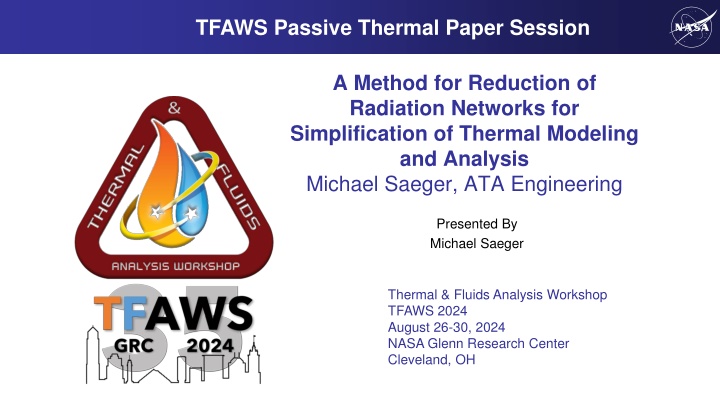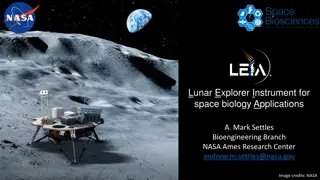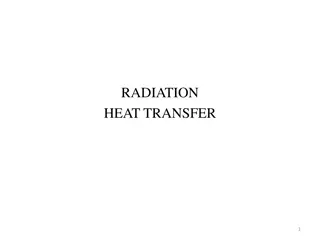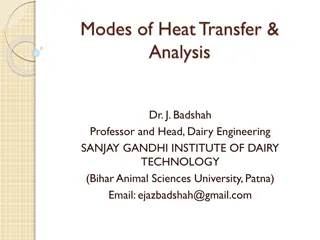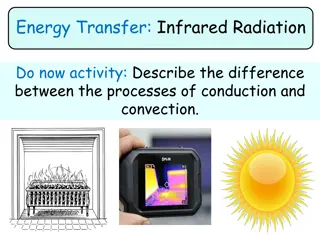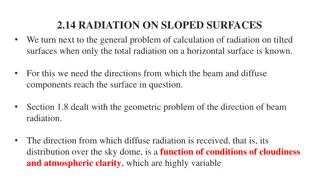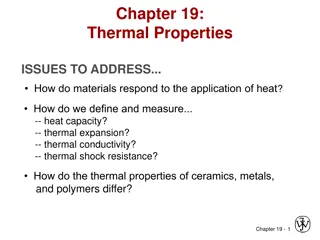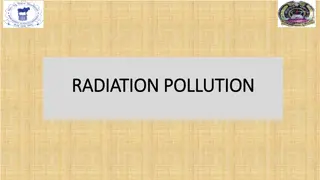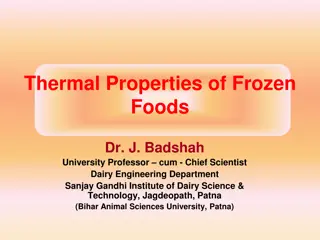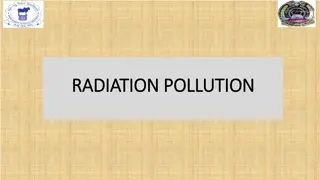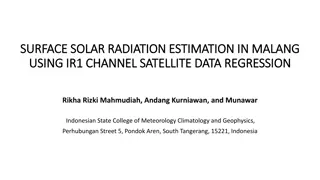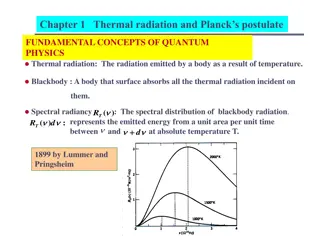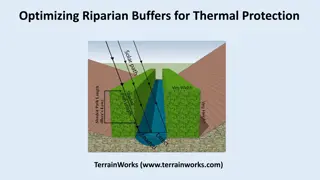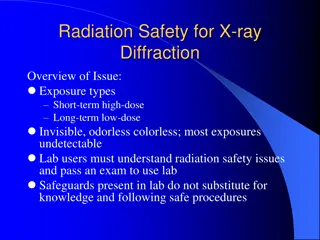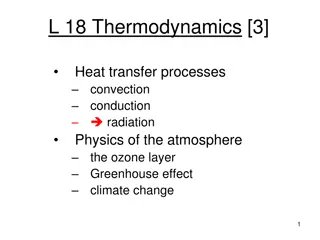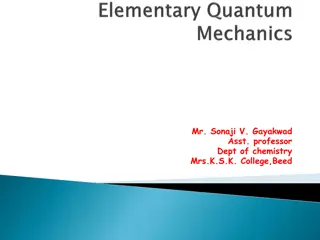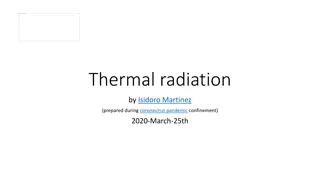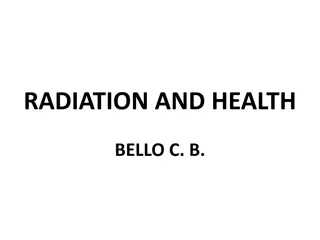Method for Reduction of Radiation Networks: Simplifying Thermal Modeling
This presentation discusses a innovative approach to simplifying radiation modeling in thermal analysis. It focuses on reducing radiation networks to streamline thermal modeling processes, enabling engineers to efficiently manage conductor counts and runtimes.
Download Presentation

Please find below an Image/Link to download the presentation.
The content on the website is provided AS IS for your information and personal use only. It may not be sold, licensed, or shared on other websites without obtaining consent from the author.If you encounter any issues during the download, it is possible that the publisher has removed the file from their server.
You are allowed to download the files provided on this website for personal or commercial use, subject to the condition that they are used lawfully. All files are the property of their respective owners.
The content on the website is provided AS IS for your information and personal use only. It may not be sold, licensed, or shared on other websites without obtaining consent from the author.
E N D
Presentation Transcript
TFAWS Passive Thermal Paper Session A Method for Reduction of Radiation Networks for Simplification of Thermal Modeling and Analysis Michael Saeger, ATA Engineering Presented By Michael Saeger Thermal & Fluids Analysis Workshop TFAWS 2024 August 26-30, 2024 NASA Glenn Research Center Cleveland, OH
Introduction Thermal models tend to have relatively few elements compared to other analysis types such as stress and CFD. In models that include heat transfer by radiation, low element count is typically made necessary by the large number of radiation conductors required to simulate radiative heat flows between elements. Consequently, thermal engineers often spend a great deal of time and effort simplifying geometry, remeshing, and otherwise manipulating models to achieve low element count. This presentation will focus on an alternate way of dealing with radiation modeling. Instead of painstakingly defeaturing geometry and making coarse thermal meshes to keep conductor counts and runtimes under control, a method of radiation reduction will be presented in which simplifying operations are performed on networks of conductors rather than on geometry and elements. TFAWS 2024 August 26-30, 2024 2
Radiation Model Size Considerations Once radiation is included in a thermal model, there is a radiative conductor between every surface element and every other surface element that it sees. The number of radiative conductors can get very big very quickly, leading to long run times and/or run failure due to exceeding memory limitations. 1000 elements 1,000,000 CONDUCTORS 1000 elements TFAWS 2024 August 26-30, 2024 3
How to Deal With Radiation (the Usual Way) IMPORT GEOMETRY SIMPLIFY/REBUILD GEOMETRY MESH GEOMETRY AS COARSELY AS POSSIBLE IMPORT STRUCTURAL FEM RUN MANIPULATE AND COMBINE ELEMENTS TO REDUCE MESH DRASTICALLY THERMAL SOLVER TFAWS 2024 August 26-30, 2024 4
How to Deal With Radiation (Using Reduction) SIMPLIFY GEOMETRY WHERE FEASIBLE IMPORT GEOMETRY RUN THERMAL SOLVER MESH GEOMETRY WITH REASONABLE NUMBER OF ELEMENTS IMPORT STRUCTURAL FEM RUN MAKE MESH COARSER IN AREAS WITH EXCESSIVE ELEMENT DENSITY RADIATION REDUCTION TFAWS 2024 August 26-30, 2024 5
Radiation Reduction Method: -Y Transform Model Reductions are based on an extension of the well-known -Y transform: TFAWS 2024 August 26-30, 2024 6
Radiation Reduction Method: Star-Mesh Transform The (less well-known) extension of the -Y transform is the star-mesh transform: All stars whose conductance sum is nonzero can be transformed into a mesh. This equation is always valid. G G i j = G ij N = n G n 1 In general, meshes cannot be transformed into a star; however, for those that can, this equation is valid. TFAWS 2024 August 26-30, 2024 7
Radiation Reduction Method: Parallel Plates Consider two parallel plates: All conductors are from side A to side B. Any star transformation produces conductors from every element to every other element which means A-A and B-B as well as A-B. A B A B A B TFAWS 2024 August 26-30, 2024 8
Radiation Reduction Method: Parallel Plates Use counter-acting stars: A B A B Cancel the unwanted A-A and B-B conductors with negative-valued stars. From the equation, only an appropriate scale factor on the negative conductors is needed and the cancellation will be exact. Gi = -c x Gi so that Gij = -Gij G G i j = G ij N = n G n 1 TFAWS 2024 August 26-30, 2024 9
Radiation Reduction Method: Generalized Past Parallel Plates Each element has both a positive conductor and a negative one: Selection of elements and grouping is very important. TFAWS 2024 August 26-30, 2024 10
Radiation Reduction Method: meshstar Transform Accuracy The mesh-to-star transformation typically is not very accurate. N = n = G G i in 1 This equation tends to give a result that is fairly close to the best possible choice for Gi, but even with the best possible Gi, agreement with the original mesh is still usually rather poor. Nonetheless, stars use far fewer conductors, so many of them can be used to approximate a mesh while still reducing the overall conductor count. TFAWS 2024 August 26-30, 2024 11
Radiation Reduction Example Model Secondary Reflector Element 1789 Support Strut Element 2048 Primary Reflector Element 212 Reflector is placed in a highly elliptical orbit facing the Earth 12 TFAWS 2024 August 26-30, 2024
Slide Title The thermal response of the antenna was studied for three radiation cases: Full Radiation Solve the thermal model with all radiation conductors included Number of radiation conductors: 2093124 Total number of conductors: 2113720 Reduced Radiation Reduce the radiation network and solve the thermal model with the reduced network Number of radiation conductors: 50148 Total number of conductors: 70744 No Internal Radiation Remove all radiation between antenna surfaces but retain radiation to space Number of radiation conductors: 8455 Total number of conductors: 29051 TFAWS 2024 August 26-30, 2024 13
Radiation Reduction Example Primary Reflector Results Temperature history comparison for primary reflector element 212 TFAWS 2024 August 26-30, 2024 14
Radiation Reduction Example Support Strut Results Temperature history comparison for support strut element 2048 TFAWS 2024 August 26-30, 2024 15
Radiation Reduction Example Secondary Reflector Results Temperature history comparison for secondary reflector element 1789 TFAWS 2024 August 26-30, 2024 16
Radiation Reduction Example Maximum Discrepancy The largest discrepancy between Full Radiation and Reduced Radiation across all simulation times is: TFAWS 2024 August 26-30, 2024 17
Conclusions A method for approximating large radiation conductor networks with significantly smaller radiation conductor networks has been presented. Use of this method on a simple example model has demonstrated good agreement between original and reduced models, with the later containing only 2.4% as many radiation conductors. Potential benefits include: Faster thermal model development time Less computer resources needed to perform a thermal simulation Faster transient thermal simulation run time Capability to solve larger thermal models Simple way to create low-conductor, system-level model of a component directly from its detailed, component-level model Quick trade studies TFAWS 2024 August 26-30, 2024 18
